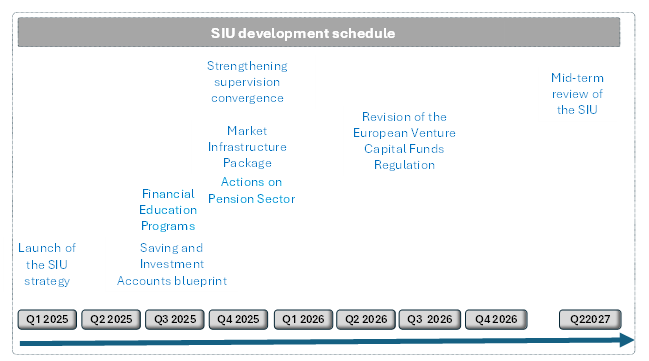
- Introduction
Recent geopolitical and geoeconomic developments are convincing European Union policymakers that they face a historic opportunity to take decisive action aimed at reversing the ongoing loss of economic, political, and technological capacity and influence vis-à-vis the rest of the world. Paraphrasing Craig David’s song “Once in a Lifetime” (2000), Europe may have now “the chance to find the key to its dreams”. For some, this moment is both urgent and possibly unique.
The Letta Report (1) highlighted the opportunity to:
- Integrate key sectors previously excluded from the single market—such as telecommunications, financial services, energy, and defense—to prevent fragmentation and enhance the EU’s global competitiveness.
- Create a new entity to channel European private savings into strategic investments.
- Reduce bureaucracy and eliminate administrative barriers, especially for small and medium-sized enterprises (SMEs), to foster growth and competitiveness.
- Reform state aid frameworks by establishing pan-European financing mechanisms.
Similarly, the Draghi Report (2) warned of the need to save Europe from a slow and painful decline with consequences that go far beyond mere economic stagnation. In order to prevent jeopardizing the continent’s global relevance, its independence, its security, its prosperity, and even its founding social model the Report underscored the urgent need to:
- Close the innovation gap by increasing R&D investment to narrow the divide with the U.S. and China, particularly in advanced technologies.
- Facilitate financing and scaling opportunities for European startups.
- Ensure that the energy transition does not excessively increase energy costs, which already hinder European industrial competitiveness.
- Reduce strategic dependence on external suppliers in critical areas such as raw materials and digital technology, thereby strengthening supply chain resilience.
While there is a broad consensus regarding the structural challenges outlined in the Draghi Report, opinions diverge on the proposed response: a massive multi-year public spending program —ranging between €750 and 800 billion through 2030. Some view this substantial investment as a time-limited but essential effort to drive breakthroughs in innovation, infrastructure, and social cohesion, especially in the aftermath of recent crises. Others argue that true transformation requires sustained medium- and long-term action focused on deep cultural change in Europe, promoting entrepreneurship, strengthening market principles and competition, fostering a culture of high achievement, reducing bureaucratic hurdles that limit economic agility, and minimizing adverse effects on productivity and effort posed by social protection programs. Additionally, some voices call for fiscal prudence, advocating for public debt reduction to more sustainable levels. They believe public spending needs to be more efficient, and this is achievable by expanding public-private partnerships and implementing strict public policy evaluation methods. Critics also caution about the complexity of implementing such a vast spending program and the risk of reinforcing state dependency. They propose complementing investments with structural reforms that facilitate SME and start-up companies access to credit, modernizing regulatory frameworks to fit a digital, globalized economy and promoting financial literacy. Thus, the debate centers on whether to pursue an accelerated transformation based on market-driven principles without entailing further increases in public spending, or alternatively, to implement a well-coordinated and consensual public spending program at the European level to generate a strong catalytic push toward enhanced competitiveness. Proponents of the latter approach argue that a gradualist approach may prove insufficient given the rapid pace imposed by the current global context.
In any case, unlocking the full potential of the single market constitutes a strategic priority in the current economic and geopolitical landscape. As both Reports underscore the critical contribution that the financial sector and financial investment can make to Europe’s structural transformation, the completion of financial market integration emerges as a fundamental prerequisite for advancing this agenda.
- Current Status of the retail financial investment in the EU
Europeans rank among the world’s largest savers. In addition, in the context of ongoing de-dollarization and shifts in U.S. asset allocations within the global economy, there is an opportunity to attract capital toward the euro—which already accounts for 20% of global reserves (3). However, the challenges seem to be formidable, and the current outlook is not very encouraging for several reasons:
- Although European households save 1.4 trillion euros a year, 80% more than families in the United States, 21% of this amount is invested in foreign markets outside Europe. (4)
- Europe lacks an efficient capital market that turns savings into investments, particularly for early-stage technologies that have game-changing potential.
- Across Europe there is a massive pool, estimated at € 8-10 billion, in low-yield bank accounts, leaving Europe struggling to meet its investment needs. (5)
- Unlike the US Treasury Bonds, Europe lacks a safe, liquid asset like Eurobonds that could generate seigniorage and lower borrowing costs for governments and businesses. (6)
- Regulatory complexity has also become excessive. MiFID and similar frameworks have introduced stringent and complex investor protection requirements that are often difficult for retail investors to understand, discouraging their participation in financial markets. The proliferation of warnings, controls, and restrictions creates negative perceptions around financial investment, fostering inertia or a preference for overly conservative products that limit long-term wealth accumulation.
- Access to financial products is also restricted, as financial institutions tend to limit the availability of complex instruments to retail investors to comply with regulations, reducing options and growth potential. Suitability and appropriateness assessments often exclude many retail investors from profitable products, resulting in overprotection that constrains wealth-building opportunities.
- Compliance with retail investor protection rules has increased costs for financial intermediaries, frequently passed on to small savers. Notably, regulatory focus on protection has not been matched by significant improvements in financial education, creating a gap between regulation and the real capacity of retail investors to make informed decisions.
- Actions agreed upon and forthcoming initiatives
Two important initiatives aimed at integrating European capital markets are currently underway.
On the one hand, the «28th regime» is a European Commission initiative, strongly backed by President Ursula von der Leyen, aimed at creating an optional EU-wide legal framework for startups and innovative companies. Originally conceived in 2011, the idea was revived in 2024 as part of a broader strategy to strengthen the Single Market and boost European competitiveness. The regime would allow companies to operate under a single, digital legal structure across all EU member states, simplifying legal and administrative requirements.
It is designed to cover key areas such as corporate law, insolvency, labor law, and limited aspects of taxation. The objective is to offer a more efficient alternative to navigating 27 different national legal systems, helping startups scale faster and reducing incentives to relocate to jurisdictions like the United States.
The initiative was formally presented in early 2025 through the EU’s Competitiveness Compass and is closely linked to the recommendations of the Draghi and Letta reports. A public consultation is expected in mid-2025, followed by a legislative proposal in early 2026. If approved, the new regime could come into effect as early as 2027.
On the other hand, in March 2025, the European Union initiated a project, called Savings and Investment Union (SIU), aiming to create better financial opportunities for EU citizens and enhance the European financial system’s ability to connect savings with productive investments. Its ultimate goal is to provide savers with more options to grow family wealth through broader access to capital markets, which in turn should stimulate business growth across Europe. The project views the SIU as a shared responsibility of EU institutions, member states, and all key stakeholders, requiring concerted efforts and close cooperation along four main lines:
- Enabling retail savers to access capital markets more effectively for higher returns as a complement to their future pensions.
- Developing initiatives to improve capital availability for companies, including SMEs
- Removing regulatory and supervisory barriers to cross-border operations of market infrastructures and asset management to facilitate efficient expansion across the EU
- Harmonizing supervisory treatment to ensure consistent approaches regardless of location within the EU.
Some key milestones of the SIU include:
- The implementation of the EU Savings and Investment Account. The objective is to create a standardized, accessible, and attractive financial product for citizens across the European Union, aimed at facilitating direct investment in capital markets. These accounts are envisioned as a common model inspired by best practices already implemented in some EU countries, such as Long-Term Savings Plans or retail investment products. They will be designed to ensure accessibility for even small savers, removing bureaucratic obstacles and lowering financial entry requirements. The initiative also seeks to harmonize or at least promote tax incentives across Member States, encouraging the use of these accounts while minimizing the impact of fiscal disparities between countries. Funds held in these accounts could be invested in a wide range of financial assets—including stocks, bonds, and mutual funds—to achieve improved long-term returns. Investor protection will be a key focus, with an emphasis on transparency, and safeguards against excessive risk and fraud. Furthermore, a portion of the savings may be directed toward strategic sectors vital to the EU, such as energy transition, technological innovation, and infrastructure, thereby supporting sustainable development and enhancing European competitiveness. A public consultation has been launched regarding the development of European savings and investment accounts. The aim is to gather feedback from citizens, financial institutions, and other stakeholders on how these accounts should be designed, implemented, and promoted across the EU.
- The launch of programs to improve financial education. The European Union is developing a comprehensive strategy to improve financial literacy across member states, recognizing its importance in strengthening retail investment and economic resilience. This includes a forthcoming EU-wide strategy by 2025, the creation of financial competence frameworks for both adults and youth in collaboration with the OECD, and digital literacy programs aimed at helping citizens navigate online financial services. Ultimately, the aim is to empower citizens to make informed financial decisions and channel more private savings into long-term investments.
- The development of the supplementary pension sector through automatic enrollment, pension benefit tracking systems, and the introduction of comprehensive pension dashboards.
- The development of a Market Infrastructure Package to strengthen market integration and supervision, improve cross-border fund provision, and mitigate operational barriers faced by asset managers. Legislative proposals are planned to remove cross-border barriers to trading, post-trading, fund distribution, and asset manager operations.
- The revision of the European Venture Capital Funds Regulation.
The table below shows a planned schedule of initiatives.

The SIU stands as one of Europe’s strategically conceived initiatives with ambitious objectives. However, its development and consolidation remain uncertain, and only time and the evolution of multiple factors will reveal the attainable level of success.
- Outstanding challenges
Expectations regarding the success of the SIU are mixed.
Many believe that participation from the private retail sector can play a key role in mobilizing capital for strategic investment projects and technology-oriented business ventures. Such engagement may occur through direct investment in financial securities, including equities and bonds, or indirectly via participation in collective investment schemes managed by financial intermediaries, such as mutual funds, pension funds, and private equity funds. In this regard, the SIU can be seen as an ambitious yet essential initiative, with the potential to enhance how European citizens’ savings are utilized. Individual investors may be incentivized to diversify their portfolios, moving beyond the traditional reliance on bank accounts and real estate, and increasing exposure to a wider range of financial instruments. Such a shift would not only enhance long-term return potential but also direct savings toward the productive economy. This could lead to a European financial landscape with a greater number of initial public offerings (IPOs) and increased investment in private equity instruments, such as seed capital, venture capital, and growth capital funds.
By contrast, some politicians oppose the SIU’s proposal to actively promote financial investment among households on ideological grounds. Moreover, some argue that, while the goal is highly desirable, the current approach to tackling the issue is excessively interventionist, potentially impeding rather than facilitating effective progress. Finally, some others point out that a path such as the SIU cannot be set in motion without addressing a change in the European social contract.
Certain left-wing political parties with influence over national parliaments and governments link the promotion of financial investments to so-called financial capitalism, opposing tax breaks for private investment as regressive policies that benefit the wealthy. They question the need for financial education targeted at children and adolescents, arguing that it might foster individualistic and speculative mindsets rather than social justice and equality. They oppose leveraging privatization processes to facilitate retail participation in IPOs, denying the benefits of popular capitalism as a means to democratize ownership and wealth. This perspective often extends to criticism of financial instruments such as investment funds and stock markets, viewed as speculative and disconnected from the real economy, while also opposing fiscal incentives for investments in SMEs and entrepreneurship. They favor redistributive state intervention over models prioritizing capital accumulation through private savings and investment and highlight financial market volatility as a source of instability and recurrent economic crises.
Beyond the ideological resistance that may hinder efforts to steer retail finance toward capital markets, the limited track record of past EU initiatives further undermines confidence in the rapid development of the Savings and Investment Union. The uneven implementation and modest outcomes of previous projects raise questions about the EU’s capacity to deliver on ambitious goals, thereby casting doubt on the feasibility and effectiveness of this new push. After all, the SIU is the successor to the Capital Markets Union originally proposed in 2014. Some analysts note, for instance, that the SIU risks overlooking the potential of old-age provision in the development of the EU’s capital market. (7) From the perspective of insurers, a comprehensive review of the Pan-European Personal Pension Product (PEPP) is long overdue. Rather than adhering to rigid structures, a genuine reform is required—one that mobilizes capital effectively and addresses poverty in old age. To date, efforts to establish the so-called PEPP have faltered due to overly restrictive requirements and detailed specifications. Such a project necessitates flexibility to respond adequately to consumer needs and to build upon proven products. Tax incentives could play a pivotal role in promoting the uptake of European pension products. However, the challenge lies in reaching an agreement on tax benefits at the European level.
Even some advocates of the importance of developing robust capital markets as a means to achieve higher levels of prosperity express caution regarding the true motivation behind the SIU proposal. Some argue that the urgent need for multi-billion-euro investments to stimulate the fragile European economy and address the EU’s ongoing loss of influence in the new geopolitical landscape is driving this policy shift toward supporting retail financial investment. In their view, this occurs after years in which saving has been actively discouraged and only because the EU currently faces elevated public debt, high tax rates but slowing tax revenues, rising expenditures due to an aging population and defense commitments, and limited room to cut spending elsewhere in other areas of the public budget.
Others are even more skeptical about the benefits of implementing the SIU under its current approach. They argue that the initiative could add yet another layer of bureaucracy to the EU and that if implemented as currently designed, its impact could be significantly adverse, potentially leading to an economy characterized by increased regulation and a diminished role for market principles. (8)
Finally, some analysts point out that the reason why Europeans hold one-third of their financial assets in bank deposits, compared with one-tenth in the US can be explained by the fact that, in Europe, the pension safety net is primarily supported by the state, whereas in the United States it relies more heavily on financial markets. This divergence stems from the differing degrees of pension system privatization in each region. In the U.S., pension fund assets represent approximately 130% of GDP, in stark contrast to only about 20% in Europe, highlighting the markedly greater role of market-based mechanisms in the American retirement system. Shifting the European financial model toward the American approach entails significant long-term implications for the social contract and the welfare state. (9)
In summary, mobilizing European household savings toward profitable initiatives that enhance the region’s technological capabilities and foster the growth and competitiveness of European companies is an objective of paramount importance. Consequently, the success of the SIU project represents significant interest for all Europeans, but pursuing this path inevitably entails far-reaching implications not only for the structure of financial systems but also for broader societal dynamics.
(1). Letta, E (2024) Much more than a market. Speed, security, solidarity. April.
(2). Draghi, M. (2024) The future of European competitiveness. September.
(3). Letta, E. (2025) « The EU has a chance to shape its own future”. Financial Times June 25.
(4) Von der Leyen, U. (2025) “Special Address at the World Economic Forum”. January 21.
(5). Martuscelli, C., Carlson, K. and Cokelaere, H. (2024) “Europe’s €10 trillion gamble”, Politico. July 29.
(6). Contreras, C. (2020) Eurobonos: ¿Son el futuro de la Política Fiscal en Europa?
(7) German Insurance Association -GDV- (2025) “Commission plan for the Savings and Investments Union falls short”.
(8). Krecké, E. (2025) “Savings and Investment Union: Hopefully just an EU pipe dream” GIS Report. May 6.
(9). Gabor, D. (2025) “Ideal of US saving model risks eroding EU’s social contract”. FT. July 2.
Autor: Carlos Contreras
Licenciado y Doctor en Economía (UCM) y M.Sc. in Economics (University of York). Profesor Titular de Economía Aplicada (en excedencia). Ha publicado en Review of Public Economics IEF, Revista de Economía Aplicada, Journal of Public Administration, Finance and Law, Applied Economic Analysis, Journal of Infrastructure Systems, Papeles de Economía Española, Información Comercial Española, Journal of Insurance and Financial Management etc. Autor entre otros libros de “El papel del gobierno en la era digital” o “DeFi: ilusiones, realidades y desafíos”.






